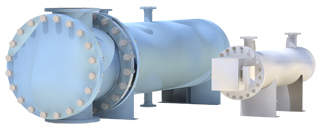Electric Process Heaters vs Shell & Tube Heat Exchangers
21 May 2014

In the process industry electric process heaters are designed, simulated and specified similar to shell and tube heat exchangers as they are used in similar applications except that the tube side is replaced by an electric heater bundle made from tubular rod elements and the heat energy is driven by electricity instead of recovered heat. In many process applications, the replacement of the tube side with electric rod element bundles brings a lot of advantages.
Head-to-Head advantages of the two heating methods are as follows:
Electric Process Heaters
|
Shell and Tube heat exchangers
|